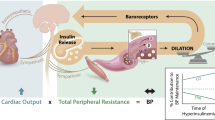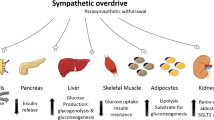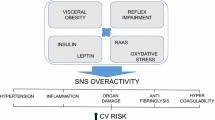Abstract
The metabolic syndrome represents a major public health burden because of its high prevalence in the general population and its association with cardiovascular disease and type 2 diabetes. Accumulated evidence based on biochemical, neurophysiologic, and indirect measurements of autonomic activity indicate that visceral obesity and the metabolic syndrome are associated with enhanced sympathetic neural drive and vagal impairment. The mechanisms linking metabolic syndrome with sympathetic activation are complex and not completely understood, and cause-effect relationships need further clarification from prospective trials. Components of the metabolic syndrome that may directly or indirectly enhance sympathetic drive include hyperinsulinemia, leptin, nonesterified fatty acids, proinflammatory cytokines, angiotensinogen, baroreflex impairment, and obstructive sleep apnea. β-Adrenoceptor polymorphisms have also been associated with adrenoceptor desensitization, increased adiposity, insulin resistance, and enhanced sympathetic activity. Because chronic sympathetic activation contributes to hypertension and its target-organ damage, sympatho-inhibition remains an important goal in the therapeutic management of the metabolic syndrome.
Similar content being viewed by others
References and Recommended Reading
Cameron AJ, Magliano DJ, Zimmet PZ, et al.: The metabolic syndrome in Australia: prevalence using four definitions. Diabetes Res Clin Pract 2007, 77: 471–478.
Grassi G, Esler M: How to assess sympathetic activity in humans. J Hypertens 1999, 17: 719–734.
Lambert E, Straznicky N, Schlaich M, et al.: Differing patterns of sympathoexcitation in normal-weight and obesity-related hypertension. Hypertension 2007, 50: 862–868.
Kingwell BA, Thompson JM, Kaye DM, et al.: Heart rate spectral analysis, cardiac norepinephrine spillover, and muscle sympathetic nerve activity during human sympathetic nervous activation and failure. Circulation 1994, 90:234–240.
Brunner EJ, Hemmingway H, Walker BR, et al.: Adrenocortical, autonomic, and inflammatory causes of the metabolic syndrome. Nested case-control study. Circulation 2002, 106: 2659–2665.
Lee ZSK, Critchley JAH, Tomlinson B, et al.: Urinary epinephrine and norepinephrine interrelations with obesity, insulin, and the metabolic syndrome in Hong Kong Chinese. Metabolism 2001; 50: 135–143.
Huggett RJ, Burns J, MacKintosh AF, Mary DA: Sympathetic neural activation in nondiabetic metabolic syndrome and its further augmentation by hypertension. Hypertension 2004, 44: 847–852.
Grassi G, Dell’Oro R, Quatri-Trevano F, et al.: Neuroadrenergic and reflex abnormalities in patients with metabolic syndrome. Diabetologia 2005, 48: 1359–1365.
Alvarez GE, Beske SD, Ballard TP, Davy KP: Sympathetic neural activation in visceral obesity. Circulation 2002, 106: 2533–2536.
Grassi G, Dell’Oro R, Facchini A, et al.: Effect of central and peripheral body fat distribution on sympathetic and baroreflex function in obese normotensives. J Hypertens 2004, 22: 2363–2369.
Vaz M, Jennings G, Turner A, et al.: Regional sympathetic nervous activity and oxygen consumption in obese normotensive human subjects. Circulation 1997, 96: 3423–3429.
Rumantir M, Vaz M, Jennings GL, et al.: Neural mechanisms in human obesity-related hypertension. J Hypertens 1999, 17: 1125–1133.
Straznicky N, Lambert E, Lambert G, et al.: Effects of dietary weight loss on sympathetic activity and cardiac risk factors associated with the metabolic syndrome. J Clin Endocrinol Metab 2005, 90: 5998–6005.
Poehlman ET, Danforth E: Endurance training increases resting metabolic rate and norepinephrine appearance rate in older individuals. Am J Physiol 1991, 261: E233–E239.
Poehlman ET, Gardner AW, Goran MI, et al.: Sympathetic nervous system activity, body fatness and body fat distribution in younger and older males. J Appl Physiol 1995, 78: 802–806.
Stein PK, Barzilay JI, Domitrovich PP, et al.: The relationship of heart rate and heart rate variability to non-diabetic fasting glucose levels and the metabolic syndrome: the Cardiovascular Health Study. Diabetic Med 2007, 24: 855–863.
Sung J, Choi Y, Park JB.: Metabolic syndrome is associated with delayed heart rate recovery after exercise. J Korean Med Sci 2006, 21: 621–626.
Weyer C, Pratley RE, Snitker S, et al.: Ethnic differences in insulinemia and sympathetic tone as links between obesity and blood pressure. Hypertension 2000, 36: 531–537.
Lambert E, Straznicky N, Eikelis N, et al.: Gender differences in sympathetic nervous activity: influence of body mass and blood pressure. J Hypertens 2007, 25: 1411–1419.
Jones PP, Snitker S, Skinner JS, Ravussin E.: Gender differences in muscle sympathetic nerve activity: effect of body fat distribution. Am J Physiol 1996, 270: E363–E366.
Abate N, Mansour Y, Tuncle M, et al.: Overweight and sympathetic overactivity in Black Americans. Hypertension 2001, 38: 379–383.
Landsberg L: Diet, obesity and hypertension: an hypothesis involving insulin, the sympathetic nervous system, and adaptive thermogenesis. Q J Med 1986, 236: 1081–1090.
Reaven G: Banting Lecture 1988. Role of insulin resistance in human disease. Diabetes 1988, 37: 1595–1607.
Grundy SM: What is the contribution of obesity to the metabolic syndrome? Endocrinol Metab Clin N Am 2004, 33: 267–282.
Julius S, Valentini M, Palatini P: Overweight and hypertension: a 2-way street? Hypertension 2000, 35: 807–813.
Masuo K, Kawaguchi H, Mikami H, et al.: Serum uric acid and plasma norepinephrine concentrations predict subsequent weight gain and blood pressure elevation. Hypertension 2003, 42: 474–480.
Gudmundsdottir H, Strand A, Kjeldsen S, et al.: Arterial noradrenaline predicts rise in body mass index in a 20-year follow-up of lean normotensive and hypertensive men [abstract]. J Hypertens 2008, 26(Suppl): S347.
Scherrer U, Sartori C: Insulin as a vascular and sympathoexcitatory hormone. Circulation 1997, 96: 4104–4113.
Vollenweider P, Randin D, Tappy L, et al.: Impaired insulininduced sympathetic neural activation and vasodilation in skeletal muscle in obese humans. J Clin Invest 1994; 93: 2365–2371.
Straznicky N, Masuo K, Lambert G, et al.: Blunted sympathetic neural response to oral glucose in insulin resistant metabolic syndrome subjects [abstract]. J Hypertens 2008, 26:S350.
Kaiyala KJ, Prigeon RL, Kahn SE, et al.: Obesity induced by a high-fat diet is associated with reduced brain insulin transport in dogs. Diabetes 2000, 49:1525–1533.
Frontoni S, Bracaglia D, Baroni A, et al.: Early dysfunction in glucose-tolerant but insulin-resistant offspring of type 2 diabetic patients. Hypertension 2003, 41:1223–1227.
Watanabe K, Komatsu J, Kurata M, et al.: Improvement of insulin resistance by troglitazone ameliorates cardiac sympathetic nervous dysfunction in patients with essential hypertension. J Hypertens 2004, 22:1761–1768.
Jamerson KA, Julius S, Gudbrandsson T, et al.: Reflex sympathetic activation induces acute insulin resistance in the human forearm. Hypertension 1993, 21:618–623.
Van Baak MA: The peripheral sympathetic nervous system in human obesity. Obes Rev 2001, 2:3–14.
Reynisdottir S, Ellerfeldt K, Wahrenberg H, et al.: Multiple lipolysis defects in the insulin resistance (metabolic) syndrome. J Clin Invest 1994, 93:2590–2599.
Masuo K, Katsuya T, Fu Y, et al.: β 2-adrenoceptor polymorphisms relate to insulin resistance and sympathetic overactivity as early markers of metabolic disease in nonobese, normotensive individuals. Am J Hypertens 2005, 18:1009–1014.
Lindgren K, Hagelin E, Hansen N, Lind L: Baroreceptor sensitivity is impaired in elderly subjects with metabolic syndrome and insulin resistance. J Hypertens 2006, 24:143–150.
Lucini D, Cusumano G, Bellia A, et al.: Is reduced barore-flex gain a component of the metabolic syndrome? Insights from the LINOSA study. J Hypertens 2006, 24:361–370.
Grassi G, Facchini A, Trevano Q, et al.: Obstructive sleep apnea-dependent and-independent adrenergic activation in obesity. Hypertension 2005, 46:321–325.
Imadojemu VA, Mawji Z, Kunselman A, et al.: Sympathetic chemoreflex responses in obstructive sleep apnea and effects of continuous positive airway pressure therapy. Chest 2007, 131:1406–1413.
Noda A, Nakata S, Koike Y, et al.: Continuous positive airway pressure improves daytime baroreflex sensitivity and nitric oxide production in patients with moderate to severe obstructive sleep apnea syndrome. Hypertens Res 2007, 30:669–676.
Phillips CG, Yang Q, Williams A, et al.: The effect of short-term withdrawal from continuous positive airway pressure therapy on sympathetic activity and markers of vascular inflammation in subjects with obstructive sleep apnea. J Sleep Res 2007, 16:217–225.
Eikelis N, Schlaich M, Aggarwal A, et al.: Interactions between leptin and the human sympathetic nervous system. Hypertension 2003, 41:1072–1079.
Alvarez G, Ballard TP, Beske SD, Davy KPD: Subcutaneous obesity is not associated with sympathetic neural activation. Am J Physiol Heart Circ Physiol 2004, 287:H414–H418.
Gadegbeku CA, Dhandayuthapani A, Sadler ZE, Egan BM: Raising lipids acutely reduces baroreflex sensitivity. Am J Hypertens 2002, 15:479–485.
Grekin RJ, Ngarmukos CO, Williams DM, Supiano MA: Renal norepinephrine spillover during infusion of nonesterified fatty acids. Am J Hypertens 2005, 18:422–426.
Grassi G, Seravalle G, Dell’Oro R, et al.: Comparative effects of candesartan and hydrochlorothiazide on blood pressure, insulin sensitivity, and sympathetic drive in obese hypertensive individuals: results of the CROSS study. J Hypertens 2003, 21:1761–1769.
Struck J, Muck P, Trubger D, et al.: Effects of selective angiotensin II receptor blockade on sympathetic nerve activity in primary hypertensive subjects. J Hypertens 2002, 20:1143–1149.
Wessel J, Moratorio G, Rao F, et al.: C-reactive protein, an ‘intermediate phenotype’ for inflammation: human twin studies reveal heritability, association with blood pressure and the metabolic syndrome, and the influence of common polymorphism at catecholaminergic/β-adrenergic pathway loci. J Hypertens 2007, 25:329–343.
Author information
Authors and Affiliations
Corresponding author
Rights and permissions
About this article
Cite this article
Straznicky, N.E., Eikelis, N., Lambert, E.A. et al. Mediators of sympathetic activation in metabolic syndrome obesity. Current Science Inc 10, 440–447 (2008). https://doi.org/10.1007/s11906-008-0083-1
Published:
Issue Date:
DOI: https://doi.org/10.1007/s11906-008-0083-1




